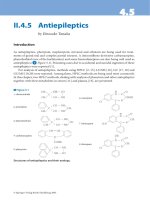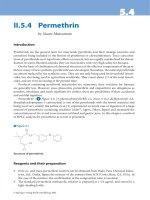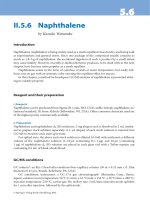Energy Storage in the Emerging Era of Smart Grids Part 1 pptx
Bạn đang xem bản rút gọn của tài liệu. Xem và tải ngay bản đầy đủ của tài liệu tại đây (2.29 MB, 30 trang )
ENERGY STORAGE IN
THE EMERGING ERA
OF SMART GRIDS
Edited by Rosario Carbone
Energy Storage in the Emerging Era of Smart Grids
Edited by Rosario Carbone
Published by InTech
Janeza Trdine 9, 51000 Rijeka, Croatia
Copyright © 2011 InTech
All chapters are Open Access articles distributed under the Creative Commons
Non Commercial Share Alike Attribution 3.0 license, which permits to copy,
distribute, transmit, and adapt the work in any medium, so long as the original
work is properly cited. After this work has been published by InTech, authors
have the right to republish it, in whole or part, in any publication of which they
are the author, and to make other personal use of the work. Any republication,
referencing or personal use of the work must explicitly identify the original source.
Statements and opinions expressed in the chapters are these of the individual contributors
and not necessarily those of the editors or publisher. No responsibility is accepted
for the accuracy of information contained in the published articles. The publisher
assumes no responsibility for any damage or injury to persons or property arising out
of the use of any materials, instructions, methods or ideas contained in the book.
Publishing Process Manager Sandra Bakic
Technical Editor Teodora Smiljanic
Cover Designer Jan Hyrat
Image Copyright design56, 2010. Used under license from Shutterstock.com
First published September, 2011
Printed in Croatia
A free online edition of this book is available at www.intechopen.com
Additional hard copies can be obtained from
Energy Storage in the Emerging Era of Smart Grids, Edited by Rosario Carbone
p. cm.
ISBN 978-953-307-269-2
free online editions of InTech
Books and Journals can be found at
www.intechopen.com
Contents
Preface IX
Part 1 Energy Storage Systems 1
Chapter 1 Electrochemical Energy Storage 3
Pier Luigi Antonucci and Vincenzo Antonucci
Chapter 2 Supercapacitor-Based Electrical Energy Storage System 21
Masatoshi Uno
Chapter 3 Rotor Design for High-Speed Flywheel
Energy Storage Systems 41
Malte Krack, Marc Secanell and Pierre Mertiny
Chapter 4 An Application of Genetic Fuzzy Systems
to the Operation Planning of Hydrothermal Systems 69
Ricardo de A. L. Rabêlo, Fábbio A. S. Borges,
Ricardo A. S. Fernandes, Adriano A. F. M. Carneiro
and Rosana T. V. Braga
Chapter 5 Lightning Energy: A Lab Scale System 89
Mohd Farriz Basar, Musa Yusop Lada and Norhaslinda Hasim
Chapter 6 Fabrication and Characterization of MicroPCMs 111
Jun-Feng Su
Chapter 7 Energy Storage and Transduction in Mitochondria 139
Bahareh Golfar, Mohsen Nosrati and Seyed Abbas Shojaosadati
Part 2 Technologies for Improving Energy Storage Systems 159
Chapter 8 Bidirectional DC - DC Converters
for Energy Storage Systems 161
Hamid R. Karshenas, Hamid Daneshpajooh,
Alireza Safaee, Praveen Jain and Alireza Bakhshai
VI Contents
Chapter 9 Bi-Directional DC - DC Converters
for Battery Buffers with Supercapacitor 179
Jan Leuchter
Chapter 10 Bio-Inspired Synthesis of Electrode Materials
for Lithium Rechargeable Batteries 207
Kisuk Kang and Sung-Wook Kim
Chapter 11 Thioether Bond Containing Polymers
as Novel Cathode Active Materials
for Rechargeable Lithium Batteries 237
Zhang J.Y., Zhan H., Tang J., Zhan L.Z.,
Song Z.P., Zhou Y.H. and Zhan C.M.
Chapter 12 Nanostructured MnO
2
for Electrochemical Capacitor 251
Mao-wen Xu and Shu-Juan Bao
Chapter 13 High Temperature PEM Fuel Cells Based
on Nafion
®
/SiO
2
Composite Membrane 279
XiaoJin Li, ChangChun Ke, ShuGuo Qu,
Jin Li, ZhiGang Shao and BaoLian Yi
Part 3 Practical Applications of Energy Storage 299
Chapter 14 Energy Storage for Balancing
a Local Distribution Network Area 301
I. Grau Unda, P. Papadopoulos,
S. Skarvelis-Kazakos, L. M. Cipcigan and N. Jenkins
Chapter 15 Sizing and Management
of Energy Atorage for a 100% Renewable
Supply in Large Electric Systems 321
Oscar Alonso, Santiago Galbete and Miriam Sotés
Chapter 16 Complementary Control of Intermittently
Operating Renewable Sources with Short-
and Long-Term Storage Plants 349
E. F. Fuchs and W. L. Fuchs
Chapter 17 Practical Application
of Electrical Energy Storage System in Industry 379
Drabek, Streit and Blahnik
Chapter 18 Predictive Optimal Matrix Converter Control
for a Dynamic Voltage Restorer
with Flywheel Energy Storage 401
Paulo Gambôa, J. Fernando Silva,
S. Ferreira Pinto and Elmano Margato
Contents VII
Chapter 19 Unified Power Flow Controllers Without Energy
Storage: Designing Power Controllers
for the Matrix Converter Solution 425
Joaquim Monteiro, J. Fernando Silva,
Sónia Pinto and João Palma
Chapter 20 The Benefits of Device Level Short Term Energy Storage
in Ocean Wave Energy Converters 439
D. O’Sullivan, D. Murray, J. Hayes,
M. G. Egan and A. W. Lewis
Chapter 21 A New On-Board Energy Storage System
for the Rolling Stock 463
Masao Yano
Preface
Traditional electrical power systems were essentially based on centralized and fuel
consuming power generation plants, where end-users were supplied via
unidirectional transmission and distribution grids.
The increasing demand for electrical energy and, at the same time, the need for reducing
CO2 emissions are now changing these strongholds, and power systems are more and
more integrated by “distributed generation” (DG), that is to say small and medium size
generator plants managed by end-users (now called “prosumers”, to underline that they
are both consumers and producers) and essentially based on renewables.
In order not to compromise reliability and quality of the supply, modern power
systems now have to become “smarter”, for properly managing power, received both
from centralized and distributed sources; of course, this could be accomplished by
means of sophisticated control and communication technologies but, in our opinion,
energy-storage systems can also have a central role.
In fact, electricity generated from renewables by distributed plants, unlike to that
generated by fuel consuming centralized plants, is highly “intermittent” and this
worsens the problem of optimally matching electricity availability with electricity
demand of end-users.
Without solving this problem, reliability, quality and stability of modern power
system are seriously compromised.
Reliable, high-efficient and cost-effective energy storage systems - undoubtedly – can
play a crucial role for a large-scale integration on power systems of DG and for
enabling the starting and the consolidation of the new era of so called smart-grids.
A non exhaustive list of benefits of the energy storage properly located on modern
power systems with DG could be as follows: it can increase voltage control, frequency
control and stability of power systems, it can reduce outages, it can allow the
reduction of spinning reserves to meet peak power demands, it can reduce congestion
on the transmission and distributions grids, it can release the stored energy when
energy is most needed and expensive, it can improve power quality or service
reliability for customers with high value processes or critical operations and so on.
X Preface
At this moment, a large number of energy storage technologies and systems are
available and effectively viable; nevertheless, existing storage technologies can be
complimented with innovative researches in order to find new, more reliable and cost-
effective solutions.
The main goal of the book is to give a date overview on: (i) basic and well proven
energy storage systems, (ii) recent advances on technologies for improving the
effectiveness of energy storage devices, (iii) practical applications of energy storage, in
the emerging era of smart grids.
The book is organized into three sections.
In the first section (chapters from 1 to 7), the basic and well proven technologies for
making up an energy storage system are reviewed.
In Chapter 1, electrochemical energy storage technologies are reviewed, also showing
how batteries, electrochemical flow cell systems, hydrogen based systems and
capacitors can be effectively used on modern distribution grids for integrating
renewable energy sources (RES), in order to improve their availability, reliability and
power quality.
In Chapter 2, specific reference is made to supercapacitors. It is shown that they can be
used as an effective alternative to traditional secondary batteries, especially in
applications where batteries have to be cycled with shallow depth of discharges, in
order to achieve long cycle lives. High-efficiency power electronic converters suitable
for overcoming some specific problems related to practical utilization of
supercapacitors (voltage imbalance in series connections and terminal voltage
variations during charging/discharging process) are also introduced and discussed.
In Chapter 3, the state of art of high-speed flywheels is overviewed. Particular
attention is dedicated to the problem of the optimization of the rotor design process
and well proven approaches for solving it are introduced and discussed, with specific
reference to a hybrid composite flywheel rotor.
In Chapter 4, the operation planning of hydrothermal systems is analysed, with the
main aim to optimize the reservoirs of the hydroelectric systems so that thermoelectric
generation can be profitably replaced, whenever possible, by hydroelectric generation.
The specification of reservoir operation rules by means of Genetic Fuzzy Systems is
investigated and the Mamdani fuzzy inference systems is efficiently used to estimate
the operating volume of each hydroelectric plant based on the value of the energy
stored in the hydroelectric system.
In Chapter 5, a lab scale system is experimented to demonstrate the real possibility to
capture the energy from lightning return strokes, as that can also be considered a clean
energy sources. The capacitor is used as energy storage device while a high-frequency
switching is used to isolate it (and its stored energy), once it has been supplied by
means of a lab-generated lightning impulse voltage.
Preface XI
In Chapter 6, the storage of thermal energy is considered. Phase change materials (PCMs)
are specifically introduced and analysed due to their well proven capability to store
thermal energy as latent heat, thanks to a constant-temperature phase-change process.
In order to obtain a high heat transfer rate, micro encapsulated PCMs are proposed to
be used; their fabrication process and their characterization are discussed in depth.
Finally, in Chapter 7, the energy storage process that characterises living organisms is
introduced. Energy transduction in animal living cells takes place on the mitochondrion
and the energy is stored in the body in the form of high-energy molecules such as
Adesonine Three-Phosphate (ATP), maintaining the body at a constant temperature of
about 37°C; the investigation of this process could be helpful in searching for an
alternative energy storage systems, if studied from a thermodynamic point of view. In
this chapter, a thermodynamic model for ATP synthesis is proposed and a quantitative
comparison between the rate of energy loss and efficiency of energetic and thermogenic
mitochondria is operated. Quantitative evaluation of different mitochondria leads to a
better understanding of their thermodynamic functions.
In the second section (chapters from 8 to 13), recent advances on technologies for
improving energy storage systems are introduced and analysed.
In Chapter 8, bidirectional dc-dc converters are considered. The most common and
economical energy storage devices in medium-power range are batteries and super-
capacitors, and bidirectional dc-dc converters could be a key element because they can
allow energy exchange between storage devices and the rest of system. High
efficiency, lightweight, compact size and high reliability are, of course, some important
requirements for bidirectional dc-dc converters. In this chapter, they are reviewed and
classified; isolated bidirectional dc-dc converters, employing soft-switching
techniques, and they are investigated with particular emphasis.
Chapter 9 includes a detailed analysis of bidirectional dc-dc converters, as well as the
characterization of their performances for power buffer utilizations. Furthermore, the
dynamic behaviour of an electrical energy generating set (like that for military
applications), with a power buffer based on supercapacitors, is specifically studied and
discussed.
In Chapter 10, a new possibility for improving electrochemical performances of
lithium rechargeable batteries (probably, the most leading candidates for large scale
energy storage devices) is investigated. In particular, it is shown that nano-structured
electrodes, based on the bio-material templates, possess superior electrochemical
performances, such as specific capacity, rate capability and cyclability, due to the
improved Li-ions and electrons supply, and strain accommodation upon cycling; that
is to say, bio-inspired synthesis can be considered as a promising way for fabricating
Lithium rechargeable batteries with improved performances.
In the same direction, Chapter 11 introduces and discusses the possibility of using
thioether polymers for fabricating novel cathode active materials for lithium batteries.
XII Preface
Thioether polymers show: high discharge specific capacity (up to 800 mAhg
−1
),
discharge voltage above 2V and good cycling stability.
Chapter 12 deals with the improvement of performances of electrochemical capacitors.
Future generations of electrochemical capacitors are expected to come close to current
Li-ion batteries in energy density, maintaining their high power density; this may be
achieved by using ionic liquids with a voltage window more than 4V, by discovering
new materials that combine double-layer capacitance and pseudo-capacitance, and by
developing hybrid devices. Concerning the materials issues, MnO
2 is one of the most
promising: it has a very high theoretical capacitance of ~1380 F/g but suffers from poor
conductivity. To further improve performances of MnO
2-based capacitors, it is
necessary to design MnO
2 materials into nano-architectures with desirable physic-
chemical features or composites with other materials, such as porous carbon or
conductive polymer.
Finally, in Chapter 13 fuel cells are considered. Fuel cells based on polymer electrolyte
membranes are considered to be one of the most promising alternative energy
conversion device and can have an important role also as energy storage systems. An
improvement of this kind of fuel cell can be obtained by incrementing their operating
temperature (at the moment it is limited at about 80 °C); high temperature avoids the
existence of two phase flow in the flow field so enhancing stability and reliability of
the system, it also reduces the power loss caused by the electrochemical polarization of
cathode and it is also beneficial to effectively making use of the exhaust heat and to
enhance the CO endurance of the anode. In this chapter, the issue of developing a new
type of proton exchange membrane that can be endurable to high temperatures (over
100 °C), still maintaining a high proton conduction, is introduced and discussed; an
effective solution is introduced and tested.
In the third section (chapters from 14 to 21), a lot of practical applications of energy
storage are considered and their effectiveness is evidenced.
In Chapter 14, the role of an energy storage system in balancing a local distribution
network area is introduced and discussed. In particular, after concerning with the
technical challenges that arise from intentional islanding of micro-grids that include
micro-generation sources, a combination of an energy storage system and a backup
generator is proposed as an effective solution for intentional islanding. A micro-grid
model is defined and studied by means of a simulation software. A methodology for
calculating the requirements of the energy storage system is introduced and utilized
referring to a case-study and, then, it is shown as the combined use of a backup
generator with an energy storage system can be profitably used for supporting the
islanding operation mode of a distribution network area.
In Chapter 15, having in mind a future scenario where a power system could be made
with 100% of renewable resources, the crucial role of an energy storage system is
evidenced and analysed referring, as a case-study, to the Spanish electric power
system.
Preface XIII
Chapter 16 analyses problems and benefits of utilizing and managing a mix of short-
term and long-term energy storage devices in a power system with intermittent
renewable resources. The chapter evidences the fundamental role of modern power
electronic converter designing and utilization together with that of a proper selection
for a complementary control algorithm.
Chapter 17 gives an overview of practical utilization of different kind of energy
storage devices in industrial applications.
In Chapter 18 it is shown that flywheel energy storage devices can be profitably used
in practice. Also in this case, the fundamental role of power electronic converters is
amply evidenced and a matrix converter is introduced and analysed together with a
proper control technique, to control the power transfer process between the flywheel
and the distribution grid. The reported results show that flywheel energy storage
devices with “predictive optimal” matrix converter control can be used as a voltage
restorer to excel in the mitigation of voltage sags and swells as well, as voltage
distortion at critical loads.
Chapter 19 shows how a three-phase matrix converter can make ease the interaction of
power electronic converters with grids, for controlling active and reactive power
flows, also without an energy storage system. Their benefits in replacing the classical
topologies with associations of back-to-back converters are evidenced by means of
simulation results and experiments referring to some case-studies.
The ocean wave energy short term variability is the main topic of Chapter 20. In this
context, the short term energy storage is considered as a possible element in the
amelioration of this fluctuating resource. With reference to a case-study based on an
oscillating water column type wave energy device, it is shown as a judicious
combination of mechanical and electrical energy storage can reduce power
fluctuations to the grid, reducing peak-to-average ratios.
In the field of electric trains, Chapter 21 deals with the possibility to use an on-board
energy storage system for the rolling stock. The proposed energy storage system is
based on both rechargeable batteries and electric double layer capacitors. In this
chapter, it is shown how an on-board energy storage system can effectively enable
energy savings and, at the same time, it is a promising tool to prevent regenerative
energy failure for rolling stock. In practice, the energy storage devices and their
charge/discharge converters are proposed to be shunt connected to main DC power
source in a typical configuration. By means of simulation case studies and
experiments, it is shown that the regeneration power can be effectively absorbed and
saved and that braking can be realized without additional energy consumptions.
Rosario Carbone
University “Mediterranea” of Reggio Calabria
Italy
Part 1
Energy Storage Systems
1
Electrochemical Energy Storage
Pier Luigi Antonucci and Vincenzo Antonucci
Mediterranea University of Reggio Calabria,
CNR Institute for Advanced Energy Technologies,
Italy
1. Introduction
The problems related to the differed time between production and use of electrical energy
produced by renewable sources makes storage systems an integral part of Renewable
Energy Sources (RES), especially for stand-alone systems. Furthermore, for grid-connected
systems, the stability of the electric system and the quality and stability of the delivered
voltage will result in a high quality system in the presence of intermediate storage. Storage
systems are particularly onerous for RES and, as a consequence, their cost and life-time
significantly affect the total cost of the whole system.
The relation between technical and economical characteristics in terms of dimension and
technology to be employed has to be singled-out and optimized depending on the
circumstances and, for different applications, in terms of release time of the stored energy
and outbound power.
The alternatives to obtain a continuous, reliable and cost-effective availability of electricity
include:
- diffusion of RES, production from clean carbon technologies and others sources
- technical evolution of the transmission grid for the connection of these sources to the
loads
- programs to meet power/energy demands and management of the loads.
The diffusion of storage technologies in the public grid include several benefits:
- the optimization of the grid for the fulfilment of base-load
- the way to facilitate the power trade-off in RES systems fluctuating over time or
available only during day-time
- easy integration in grid of the energy requirements for hybrid vehicles
- the chance of investments differentiation in the distribution grid to be adapted to
temporary peak-loads.
- resources for the provision of auxiliary services directly to the electricity provider.
The different storage technologies can be classified on the basis of the different
methodologies utilized:
- mechanical (compressed air energy storage, flywheels)
- electrochemical (lead-, nickel-, high temperature salts-, redox-batteries, hydrogen.
- electrical (capacitors, supercapacitors).
Although some storage technologies could work for several applications, the most part of
the different options is not economically applicable to different functional categories. Their
Energy Storage in the Emerging Era of Smart Grids
4
assessment must be done on the basis of several parameters which establish their
applicability:
- power level (nominal, pulsed)
- energy storage level (at different charge and discharge rates)
- memory effect
- power density
- energy density
- overall cycle efficiency
- life-time (number of cycles and performance)
- operative characteristics
- environmental impact (LCA)
- recycle opportunity and costs
- investment costs
- maintaining costs
Technology State of the art
Short term
application
Medium term
application
Lead acid, NiCd
Commercially
available
Off grid
demonstration
Niche markets
HT batteries
Commercially
available
Demonstration
Probable, potentially
with PV
Redox batteries Lab prototypes, dem Dev & demonstration Probable
Lithium batteries Lab prototypes, dem Dev & demonstration Probable
Hydrogen
Lab prototypes &
dem
Demonstration
Possible, niche
applications
Capacitors
Near to the market
(small size)
Required
development
Possible attainment of
commercial targets
Table 1. Technological and commercial maturity of the different technologies is summarized
Technology Commercial maturity Costs
Lead acid
Ni-Cd
S S
Ni-Mh
S S
Na/S
ZEBRA
S
Zn/Br
S
Lithium ion
S
Redox (V)
S
Supercap
S S
RFC
z z
Table 2. State of the art of electrochemical technologies
Electrochemical energy storage
5
Symbol Commercial maturity Costs
Mature product, several units
sold
Price list available
S
Commercial product Prices on request
Protot
y
pes under construction
tests in progress
Defined per single project
z
Only projects available Estimated
Table 2. State of the art of electrochemical technologies (continuation)
This chapter deals with the analysis of electrochemical technologies for the storage of
electricity in stationary applications able to meet present and future challenges for the three
following goals:
- Power quality: stored energy to be delivered for seconds in order to guarantee the
continuity of stabilized electricity supply
- Bridging power: energy furnished for minutes to guarantee the continuity of the service
during the transition from an energy source to another one.
- Energy management, for the time-lag between the production and the utilization of the
produced energy. A typical utilization is the optimization of the load level when the
energy cost is low and utilization when the cost from the grid is high.
- (Antonucci P.L., 2010, Antonucci V., 2011, Strbac G. & Black M. 2004, Stuntz. L, 2004.,
Makansi J. & Abboud J, 2002).
Application Power Energy
Domestic 1 kW 5 kWh
Commercial 10-100 kW 25 kWh
Distribution grid 10-100 MW 10-100 MWh
Table 3. Typical intervals and parameters of the different applications
Fig. 1. The state of the art of storage technologies (source: EPRI)
Energy Storage in the Emerging Era of Smart Grids
6
At present, the most common electrochemical storage technology is represented by lead-
acid batteries. In USA the current market of lead-acid batteries for commercial, industrial
and automotive applications is about 3 billion dollars per year, with an annual rate of
growth of 8.5%.
For what concerns the most recent applications (distributed generation, peak shawing,
power quality), the use of lead-acid batteries has been widely demonstrated, but costs and
life-cycle characteristics are not satisfactory for these applications, characterized by high
number of cycles.
On the other hand, the use of Li ions batteries for mobile applications is rapidly increasing,
with an annual growth rate of 50-60%. For stationary applications (in particular, for mitigation
of the variability of renewable sources), their potential has not yet been thoroughly explored,
as well as their cost-effectiveness, except for some auxiliary storage systems.
Others electrochemical technologies for backup systems include sodium-sulfide, zinc-
bromide and redox vanadium batteries. The sodium sulphur and zinc bromide technologies
are rapidly expanding in Japan and USA. Nickel cadmium and Nickel MH are used in
power backup systems.
The pressing demand of better storage technologies have produced incentives to the R&D
sector and financing through venture capital. In this regard, R&D is addressed to a base-
electrochemistry level in order to single-out the combinations of chemicals having the
maximum potential in energy storage systems.
2. Batteries
Batteries are devices that convert the chemical energy contained in an electrochemically
active material directly into electrical energy by means of a redox reaction. For a
rechargeable system, the battery allows to store a defined amount of chemical energy and
can be re-charged when the electrochemically active material has been transformed.
They are the most established way of storing electricity. Several types of rechargeable
systems exist, from the mature lead acid to different newer technologies at various
developmental stages.
Recently, new demands of portable and transport applications, as well as of power
electronics and use of large scale systems for utility applications have determined further,
dramatic development of new battery technologies.
2.1 Lead acid
Lead acid represent more than 90% of the whole batteries market. Main constituents are the
lead negative electrode, the lead dioxide positive one and the separator, with sulphuric acid
as the electrolyte. The flooded type requires the filling up with distilled water, whereas the
sealed, maintenance-free type has an absorbed electrolyte.
At present, typical lead batteries for transportation have a polypropilene external case, high
performance separators based on glass fibre, polyethylene or polyvinyl chloride matrices,
thin grids with extremely low Sb content or based on Pb-, Ca-, Sn- Al alloys. The effect of
additives has been investigated and optimized, allowing to reduce or cancel the necessity of
maintenance.
The continuous development of the technology has caused important improvements in its
capabilities, resulting in low costs and high reliability. The main drawback remains,
however, its low energy density due to the high density of lead.
The so-called “advanced lead” uses carbon additives in the negative electrode in order to
increase its life-time; this type is still at a developmental stage.
Electrochemical energy storage
7
The trend to produce lead batteries having superior performance, cyclability characteristics
and life-time are dictated by the increasing demand of electrical energy for distributed
generation, for hybrid vehicles, for auxiliaries in internal combustion engines. Future lead
batteries will be characterized by the use of new materials with impact on the design,
recovery, recycle, disposal and refining. The optimization of the whole cycle including
production, use, recovery and recycle, driven by an appropriate life-cycle analysis, will be of
fundamental importance.
2.2 Nickel Cadmium
Nickel-Cadmium (Ni-Cd) batteries represent a good compromise between specific energy,
specific power, life cycle and reliability. They are constituted by a positive plate of nickel
oxy-hydroxide (NiOOH), a negative one of cadmium (Cd) and an aqueous solution of
potassium hydroxide (KOH) as the electrolyte. During discharge NiOOH is converted to
Ni(OH)
2
, which is restored during charge. Cd is converted to Cd(OH)
2
during discharge,
and is restored during charge. The toxicity of Cd has led to the development of Ni-MH
batteries, based on metal hydrides. These are similar to the Ni-Cd, the main difference being
the composition of the negative plate made of hydrogen adsorbed on a metallic alloy. This
can be of the type AB5 (mixture of nickel and rare earths) and AB2 (mixture of nickel and
titanium, vanadium and zirconium). This type of battery is at present used in some hybrid
vehicles.
Two designs have been developed for this technology, namely the pocket plate and the
sintered plate. In the first, the active material is held between steel plates; the sintered plate
configuration uses different materials as current collector, and the active substance is
sintered onto these. The manufacturing process is more expensive than for lead acid,
resulting in a higher cost for this technology. Furthermore, this suffers from “memory
effect”, resulting in a full charge only after a series of full discharges. This effect can be
mitigated by an appropriate management procedure. A significant advantage over lead acid
is represented the lower maintenance requirements.
2.3 Lithium ion
Historically, Li-ion were the first Li batteries developed for portable electronics (cellular
phones, cordless, notebooks). They have the highest power density of commercial batteries.
The anode is made of metallic Li, Li alloys or Li-C intercalation compounds. The electrolyte
is based on non aqueous compounds, such as LiClO4 or LiPF6. The next generation
batteries will use a polymer electrolyte containing Li dissolved in a polar polymer such as
polyethylene oxide (PEO). The cathode is made of intercalation structures containing void
channels or layers, able to accept Li ions, and a mixed valence in the host framework, able to
receive or give electrons. TiS
2
has such a structure; it is able to receive Li ions in the void
spaces separating the TiS
2
adjacent layers. To maintain the electroneutrality electrons must
enter into the material. The intercalation reaction can be so written:
Ti
4
+ S
2
+ xLi = Li + xTi
4
+ 1-x Ti
3
+ xS
2
.
Many others intercalation compounds can work as a cathode. The most commercially
diffused is LiCoO
2
, which has alternated layers of Li and Co ions in octahedral sites inside
the ccp lattice of the oxide ions. The LiCoO
2
formula is referred to the completely
intercalated form when the battery is discharged. During recharging Li ions are removed
and the oxidation of Co
3+
to Co
4+
occurs. The Co
3+
/Co
4+
couple supplies a cell voltage of
about 4.0V vs. metallic Li.
Energy Storage in the Emerging Era of Smart Grids
8
New configurations have been developed for stationary applications, with titanate at the
anode and manganese at the cathode. Cost is at present very high; its reduction is linked to
an eventual increase in production. Current energy density values reach 175 Wh/kg, with
cycle lives as high as 20,000 cycles.
Recently, great interest has raised for sustainable mobility (HEVs, EvS, HEV&FC, scooters,
motorcycles, electrical bicycles). In spite of a remarkable growth of the market, the scientific
development of Li-ion batteries is often exposed to criticism because of its slow
development in comparison with other technologies like semiconductors. The world market
of Li-ion batteries is controlled by a limited number of great companies, most of which
located in Asia (Japan, China, Korea, more than 90% of those commercialized in the world).
The main users (Europe and USA) produce only 5-10% worldwide, USA being leader in
R&D due to projects funded by DoE, NIST and DoD (Fig.2).
Fig. 2. World production of Lithium batteries
Fig. 3 shows the market trend of Li batteries from 2004 to 2012. The yearly growth is
15-20%, with even more promising scenarios in the case of introduction of HEV into the
global market. Fig. 4 shows the market trend of conversion and storage of energy (source:
Lux Research, 2008). Its value in 2011 is about 50 bln dollars (10 bln for Li batteries only, 20
bln for lead and 2 bln for NiMH).
4
6
8.3
12.4
16
0
2
4
6
8
10
12
14
16
MLD US $
2004 2006 2008 2010 2012
Fonte: Lux Research
Fig. 3. World market of Lithium batteries
Source: Lux Research
Electrochemical energy storage
9
Fig. 4. Storage systems: world market values
2.4 High temperature batteries
2.4.1 Sodium sulphur
The battery consists in a positive electrode constituted by fused sulphur and a negative one of
fused sodium separated by a ceramic electrolyte (sodium ions of beta alumina). The discharge
process consists in the formation of sodium sulphide (sodium ions cross the electrolyte and the
electrons go to the external circuit). The process is obviously reversible (charge phase). The
discharge reaction is: 2 Na + xS = Na
2
Sx, where x is dependent on the charge level of the cell.
During the first steps of the discharge process, x is estimated to be equal to 5, approximately
corresponding to the sodium sulphide formula more rich in sodium, Na
2
S
5
. The OCV depends
on the charge level and on the temperature (max value: 2.08V).
The working temperature is about 300°C. This results in improved performance in
comparison with room temperature systems, requiring yet efficient insulation to prevent
heat losses, as well as a heat source using the stored energy of the battery itself. As no self-
discharge occurs, efficiencies near 90% are usually reached. Yet, they have room for further
development.
2.4.2 Sodium nickel chloride
Sodium-nickel chloride batteries (“ZEBRA”, Zero Emission Battery Research Activity)
possess a high energy density (120 Wh/kg) with high performance (180 W/kg). The
operation temperature range is 270-350°C; they work in a thermal chamber. The nickel
chloride allows high capacity (500 Ah). Furthermore, the solid electrolyte allows tolerance
towards possible short circuits and self-discharge. The substitution of fused nickel chloride
with fused iron chloride would make the system more promising but, to maintain FeCl
2
in
the fused state, the cathode (Fe/FeCl
2
) has to be impregnated with fused NaAlCl
4
. The
reactions occurring in the cell are:
2
2
2Na NiCl 2NaCl NiE2.58 V
2Na FeCl 2NaCl FeE 2.35 V
+=+=
+= +=
(1)
Energy Storage in the Emerging Era of Smart Grids
10
In comparison with sodium sulphur they have better safety characteristics and higher cell
voltage. The disadvantages consist in the actual lower energy and power density.
Fig. 5. Zebra battery
3. Electrochemical flow (redox) cell systems
Flow or redox batteries are electrochemical devices halfway between secondary batteries
and fuel cells. The energy is stored in two electrolytes, separated by an ion exchange
membrane. There is no electrochemical reaction between the electrolytes and the electrodes.
They can supply power as long as they are supplied with electrolytes.
There is a conceptual difference between power and energy properties. The delivered power
depends upon electrodes dimension and number of cells, whereas the storage capacity is
determined by the volume of the reservoirs that contain the electrolytes flowing through the
cells. For a given power absorption, the energy capacity can be increased by introducing
more electrolyte (that is, using more capacious reservoirs). Therefore, flow batteries are
particularly advantageous for high energy (long term) applications, when several hours of
storage are required. The recharge capacity is equivalent to the rapidity of refilling,
therefore this kind of battery appears particularly promising for mobile applications.
Compared to other types of batteries, redox systems have an outstandingly long life
(unlimited in theory) and no operative limitations (no memory effects or problems
connected with discharge).
Electrochemical energy storage
11
3.1 Vanadium Redox Battery (VRB)
The vanadium technology is based on the four oxidation states of V, exploiting the V
2+
/V
3+
transition one side of the membrane and the V
5+
/V
4+
transition of the other. The use of V
sulphates or, more recently, V halides on both sides considerably simplifies the electrolyte
management.
Reactions occurring during charging and discharging are:
charge
4+ 5+
discharge
VV+e-
⎯⎯⎯⎯⎯→
←⎯⎯⎯⎯⎯
(2)
charge
3+ 2+
discharge
V+e- V
⎯⎯⎯⎯⎯→
←⎯⎯⎯⎯⎯
(3)
VRB can be suitable for different applications, such as enhanced power quality, UPS, peak
shaving, increased security of supply and integration with RES. Due to their low energy
density, major development is addressed to stationary applications.
3.2 Zinc bromine
The negative zinc electrode and the positive bromine electrode are separated by a
microporous separator. Circulation of zinc solution and bromine compounds occurs
through the two cell compartments from the respective reservoirs. In the charging phase
zinc is electroplated on the cathode while bromine evolves at the anode and stored at the
bottom of the positive electrode reservoir. On discharge, zinc is oxidized to its ions, while
bromine reduces to bromide ions.
Positive electrode:
charge
-
2
discharge
2Br Br + 2e-
⎯⎯⎯⎯⎯→
←⎯⎯⎯⎯⎯
(4)
Negative electrode:
charge
2+
discharge
Zn + 2e - Zn
⎯⎯⎯⎯⎯→
←⎯⎯⎯⎯⎯
(5)
Discharge times range from few seconds up to several hours. Demonstration projects are
primarily focused to on-grid utility applications for load levelling and RES optimization.
3.3 Polysulphide bromide (Regenesys
TM
)
This system utilizes the reversible electrochemical reaction between two salt electrolyte
solutions:
() ( )
24 22 3
3 NaBr Na S charging 2Na S NaBr dischar
g
in
g
+↔+
(6)
Previously developed over the past fifteen years, the system has been marketed as a grid-
linked utility storage system for more than 5 MWe. Actually, no development or
commercialization programs are foreseen.
4. Hydrogen storage systems
The storage of electricity is feasible by producing hydrogen through water electrolysis. The
as produced hydrogen is stored in compressed gas or liquid form or through solid









